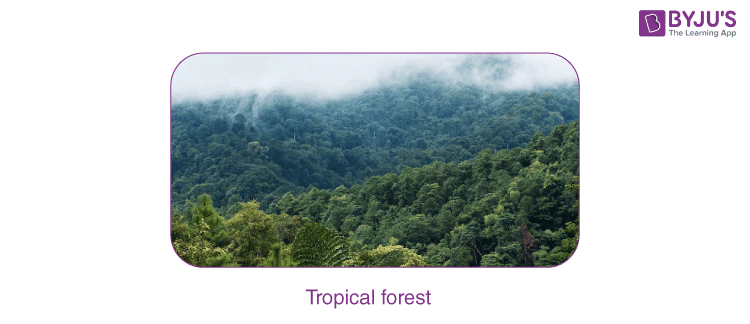Tropical Forests are called the “Cradles of Diversity”.
Forests are a precious resource provided by nature, which provides shelter for many animals, birds, insects, reptiles and other living species. It is also a house for varieties of plants and trees, from creeper to climber, herbs to shrubs and long and giant trees.
Apart from animals and other living species, we all depend on these natural resources for many things.
Forest ecosystems are a critical component of the world’s biodiversity compared to other ecosystems. Globally, 5 to 6 per cent of the earth’s land surface is covered by dense forests. About 70 to 80 per cent of the world’s documented species can be found in these tropical forests.
Explore more: Forests
What are Tropical Forests?

Tropical forests also refer to tropical rainforests, with continuous rainfall throughout the year. These include evergreen, seasonal, cloud forests, tropical and subtropical. The tropical forests are situated in a broad zone outside the equator. Globally these forests are found near the southern parts of Asia’s West coast of India. Other tropical rainforest places include Eastern Madagascar, New Guinea, the West coast of India, Assam, Australia, the Zaire basin, and the Pacific and Caribbean islands.
These rainforests consist of both biotic and abiotic factors and are the largest ecosystems.
Types of Tropical Forests
- Moist, deciduous and semi-evergreen season.
- Flooded forest – They are found near the Amazon Basin of South America, Indonesia and near the Congo Basin of Central Africa.
- Montane rain forests or cloud forests – Found near the Indian subcontinent, around the Caribbean, Central America and other parts of Western coastal Africa.
- Lowland equatorial evergreen rain forests – Found in mountain ranges between the altitude of 1500 and 3300 m.
Explore more: Ecosystem and Their Types
Features of Tropical Forest
An essential feature of the tropical rainforest is moisture, and the major limiting factor is sunlight. It occurs in areas of heavy rainfall, with relatively high temperatures and humidity throughout the year. The yearly rain exceeds 2000 to 2250 millimetres, which ranges over the year. The average climate of these tropical rainforests varies from warm and wet, with the average annual temperature above 30 degrees C. The yearly rainfall exceeds 2000 to 2250 millimetres, which ranges over the year.
Also Refer: Effects Of Climate Changes
Animals and Plants of Tropical Forest
The tropical rainforest is a wet and warm forest of trees that grow very closely together. The moisture keeps the forest interior warm and humid. Animals living in these rainforests have been adapted to wet and warm climatic conditions.
The tropical rainforest is abundant with many species of wildlife and vegetation. Here we can find a great and wide variety of colourful birds, dangerous animals, insects and a lot more. Other animal species include jaguars, mountain gorillas, howler monkeys, squirrels, monkeys, both poisonous and non-poisonous snakes, wide varieties of insects and a lot more.
Nutrient-rich soil gives rise to tall trees that grow above 50 metres in height, and their trunks measure 4 to 5 metres around with hardwood and broad leaves. Overall, these trees look pretty similar to the umbrella from the top view of the forest. The most common plants and trees of tropical forests include a wide variety of climbers, creepers, epiphytes, stranglers, ferns, lianas, etc.
Also Refer: Adaptation And Habitats
Resources of Tropical Forest
Tropical forests have maximum rates of terrestrial biodiversity with the most significant living biomass. They are the most endangered habitat on earth and most vulnerable to deforestation.
Around 140,000 sq. km of tropical forests are destroyed for timber and other wood products every year. With the doubling of the human population every 5 to 10 years, dense and substantial tropical forests are disappearing at an alarming rate.
Explore more: Forests- Our Lifeline
This article concludes with an introduction to tropical forest, its features, habitats and resources.
For more detailed information on forests and other related topics, keep visiting our website at BYJU’S Biology.
Related Links:

Comments